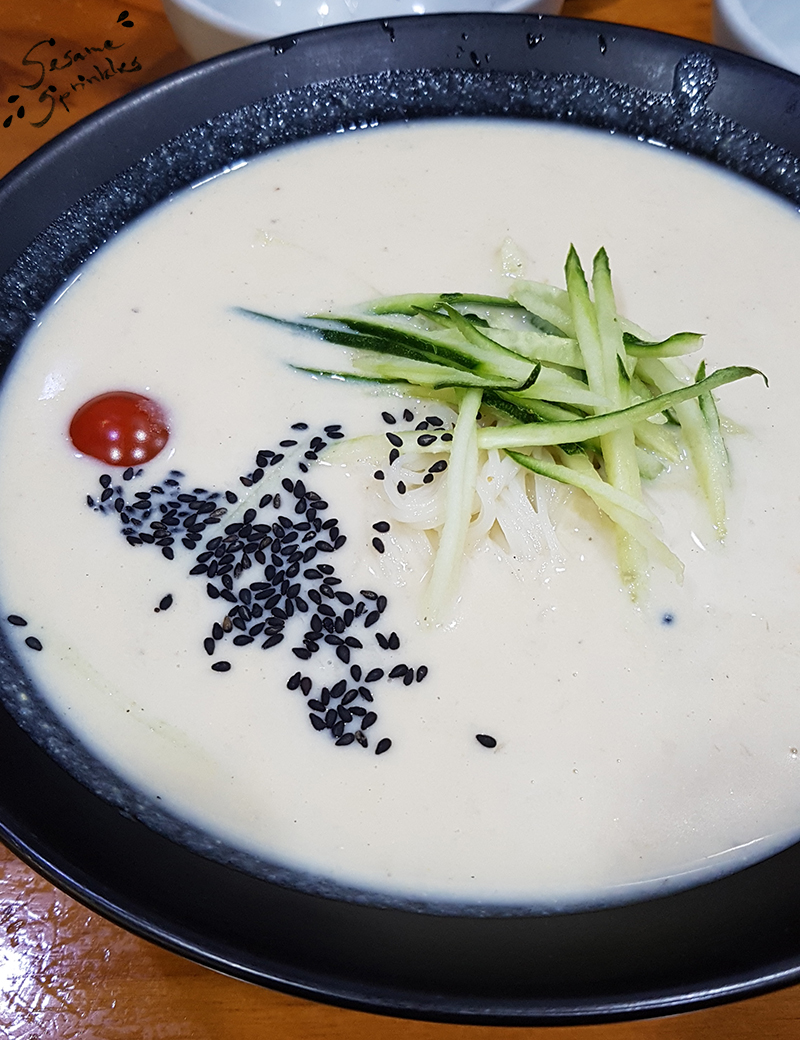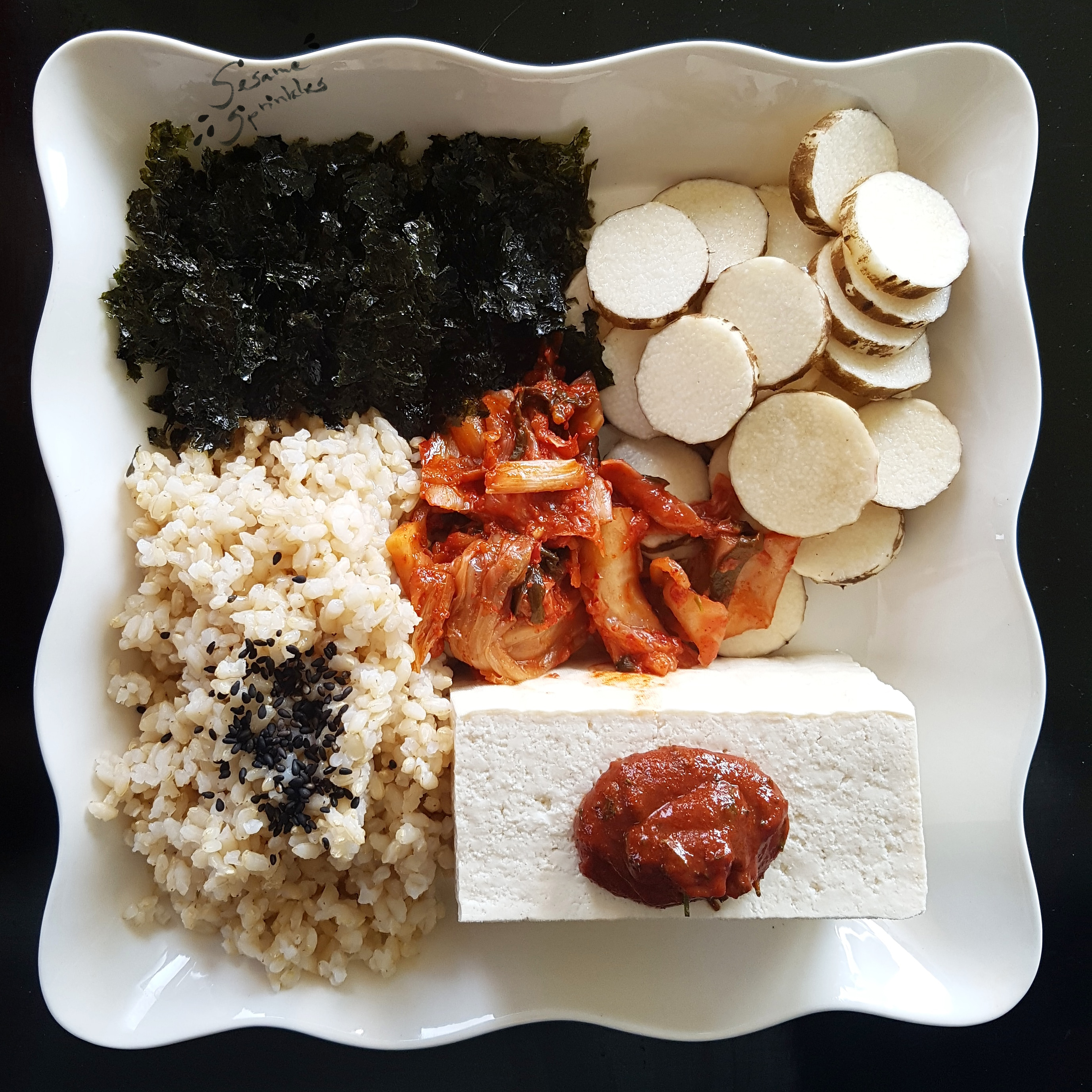🌡 Temperatures are rising, people are beginning to sweat in an instant. 💦 Strong indicators of summer having arrived. ☀️ Du-dung du-dung…. *dramatic music*
Run for your lives!!! As long as you can… 😱
Or enjoy the return of Korea’s summer delicacies (yeoreum byeolmi 여름 별미)! ☀️🤤🍧

One of these is Kong-guksu (콩국수) – long noodles in chilled soy milk! The dish is served cold and may be garnished with a few toppings – fine slices of cucumber🥒, sesame seeds or half a boiled egg🥚 are almost standard. Actually, very simple! But quite filling and perfect in the midst of summer! There may even be ice cubes floating in the soy milk for the ultimate cool-down! ❄️
This dish is traditionally vegetarian and it is easily veganized by removing the occasional egg. Best is to tell restaurant staff right upon ordering that any potential egg🥚 topping may be omitted in your serving.
Saying this short sentence should do the trick:
Kong-guksu gyeran eobsi juseyo. “콩국수 계란 없이 주세요.” –
“Please give me Kong-guksu without egg.”
What is Kong-guksu made of?
Besides the toppings, there are generally no large variations to this dish.
The basic formula is:
cold soy milk + long noodles + garnish = Kong-guksu

(kalguksu 칼국수)
Normally, plain wheat noodles, which are rather thin and referred to as somyeon (소면) or slightly thicker jungmyeon (중면), are used. But some locations prepare the dish with more “special noodles”, e.g. hand-cut kalguksu (칼국수) or differently colored noodles, to distinguish themselves from competing restaurants.
The quality of the soy milk, however, is key. In general, the soy milk in Kong-guksu is much thicker than regular soy milk (duyu 두유). Hence it is actually referred to as kong-guk (콩국 – “bean soup”), kong-mul (콩물 – “bean water”) or kong-gukmul (콩국물 – “bean broth”) in Korean. Certain restaurants prize themselves for producing it on location, or for adding ground nuts, peanuts or sesame to make it extra creamy and nutty, or for using black soy beans (seoritae 서리태 or geomeun kong 검은콩). Occasionally, the liquid is still frothy from blending the ingredients prior to serving. Correspondingly, there will be slight variations in color and texture instead of being creamy-white and watery like plain soy milk.




What does Kong-guksu taste like?
Overall, the taste of this cold dish featuring noodles in soy soup is rather subtle. It has a pure taste, as mild (담백하다) as plain (soy) milk, and may smell a little bit nutty (고소하다), if roasted nuts or sesame seeds have been added to enhance the aroma. [If the beans have not been properly prepared, there will be a hint of a fishy smell (birinnae 비린내) as well.] Since the basic broth normally contains hardly any salt at all, kong-guksu is served with salt and sugar, and people can season it individually. Common Korean spices such as garlic, onion or chili are not used at all. In this regard, Kong-guksu is quite different from most dishes, which typically exhibit stronger and more exciting flavors. Yet, since many Koreans tend to lose their appetite during the intense heat, this dish is the ideal summer meal!

But, how do you eat Kong-guksu after all? First of, the dish is served inside a large bowl, in which you will find the freshly cooked noodles. Soy broth has been poured over the noodles and garnish has been neatly arranged on top of it. Before eating, you mix the noodles and toppings with the soy soup, while using chopsticks. As mentioned before, the dish is barely seasoned, so one adds salt or sugar according to one’s personal liking. Since the noodles are rather long, it might be difficult to transfer large portions into the mouth. The soup is eaten using a spoon and not by lifting the bowl and drinking it.
Where can you find Kong-guksu?
Kong-guksu is frequently offered in Korean restaurants, including those specializing in soups or noodle dishes as well as small restaurants of the bunsikjeom type. However, restaurants serve this dish only during the warmer months of the year (max. April until November). It is then labeled as “seasonal menu” or “summer special” (계절 메뉴 / 여름 별미 / 여름 별식) and advertised separately, i.e. sometimes it’s not listed on the regular menu but visible on extra posters inside or outside the restaurant. Owing to production costs, the price of Kong-guksu is higher when the soy milk is “home-made”. The lowest price I’ve seen in Seoul was 7000 KRW, but the average is 9000-10.000 KRW for one serving.








Great post! I learned so much about 콩국수 thanks to you 🙂
Woah, I’ve never seen black 콩국수 before; I really want to try it now! Do you prefer sugar or salt? Or both?
LikeLike
Im so glad to hear that 🙂 Personally, I prefer salt in my Kong-guksu! The idea of adding sugar doesnt work with me, lol! Did you try sugar in yours?
Do try black 콩국수 if you get a chance! Or those with black sesame in them, they are so 고소하다 ~^^
LikeLiked by 1 person
I’ve never tried it with sugar either (and I don’t think I will because it sounds a little weird honestly haha) but I LOVE back sesame, so I’ll try that one!
LikeLiked by 1 person